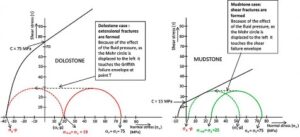Solution Exercise 5
a) In the case where fluid pressure (p) is present, the Mohr circles would be displaced to the left, as shown in the diagrams below (vertical and horizontal axes are in MPa). The differential stress would remain the same because the fluid pressure is isotropic and reduces all of the stresses, in all directions, by the same amount.

b) If the fluid pressure is high enough, the Mohr circles would be displaced to the left until each one intercepts its own failure envelope. In this situation, extension fractures are formed in the dolostone and shear fractures in the mudstone. The cohesion (C) of the dolostone is higher, so the lithostatic stresses would reach point T of the Griffith failure envelope and joints would be formed. On the other hand, the cohesion (C) of mudstone is lower; under the same lithostatic condition, its Mohr circle would reach the shear failure envelope (Mohr- Coulomb envelope), and shear fractures would be formed.
c) The Mohr diagram demonstrates that specific stress conditions can reach only one of the failure envelopes, so it is not possible to propagate both opening mode and shear mode fractures in the same rock, in a given location, at the same time.
Click to return to where text linked to Exercise 5
